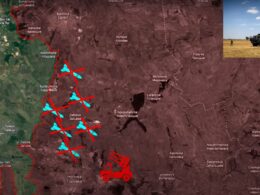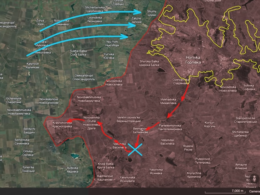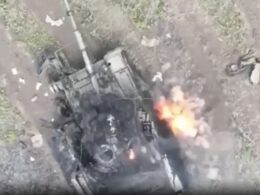Day 803: 6 May 2024
Today, there are a lot of updates from the Kurakhove direction, Donetsk Oblast.

Here, Ukrainian forces decided to withdraw from Novomykhailivka after months of fierce resistance due to the intense Russian pressure on the settlement.

The battle for this settlement has been ongoing since the end of autumn, and it has become the location of one of the largest graveyards of enemy equipment of this war.
Novomykhailivka, a small village with barely 1500 inhabitants prior to the conflict, became one of the highest priorities of the Russians on the entire front line since it became an immediate step on their way to Kostiantynivka, an essential logistic node located on the P0532 road, and from which Vuhledar is logistically supplied. In turn, Vuhledar, one of the Ukrainian strongholds still resisting Russian attacks, is located at the apex between the north-south and east-west front lines, and additionally is the closest point to Mariupol and its influence zone, located about 80 kilometers away, and therefore just at the range limit of the HIMARS standard ammunition systems. So, for the Russians, shifting the front line even a few kilometers beyond Vuhledar is a big priority.

Novomykhailivka has been defended among other units by the 79th Separate Airborne Assault Brigade, one of the best prepared and equipped elite units of the Ukrainian army. It’s been reported their very frequent use of Western equipment, such as Javelin missiles, helped in the destruction of a lot of tanks and infantry transport vehicles in the area. In recent statements, their commander, Colonel Yevgeny Shamatalyuk, detailed how his units have faced a Russian force composed of at least eight regiments and two brigades in the Novomykhailivka area.

This is about 30,000 soldiers for this small section of the front line, which means a seven-to-one disadvantage for the defenders.

Recently, the 79th Separate Airborne Assault Brigade reported that Russia had lost 314 pieces of equipment over six months of fighting around Novomykhailivka and released a detailed video to document this claim.

The striking footage combines impact images and geolocated debris over the six months. The video and the additional published material allow us to analyze the attack on the village over this period.

Firstly, Ukrainian defenders faced an attack from multiple vectors, frontal and from the north and south flanks.

However, in the first weeks, the attack was stopped to a large extent, especially in the northern and frontal vectors, given that the numerous assaults had to cross many densely mined areas and open fields.

Ukrainians repelled these attacks with the help of superior recognition capabilities, which allowed the preparation of overwhelming ATGM, artillery, and drone fire well in advance.
Secondly, in the face of Ukrainian solid resistance, the Russian forces only found a way to advance by employing massive bombardment while incurring disproportionate losses, both in unsuccessful mechanized assaults and through infantry meat waves.

According to different reports, due to the extremely high loss rate, Russians had to deploy additional operational reserves. But in the end, these successive waves achieved incremental advances that allowed several weeks later to cross the outskirts of the village and enter it.
However, the massive bombardment with artillery and FAB bombs completely wiped out buildings and fortifications inside the settlement, making the defense of the town untenable, given the impossibility of maintaining defensive positions in mere ruins and shell craters.

For this reason, the Ukrainian defenders had no other option but to gradually withdraw from the town.

Incidentally, some analyst reports indicated that the massive FAB bombardment not only paved the way by undermining Ukrainian fortifications but also helped to clear densely mined areas right on the edge of the town.
After the confirmation of the withdrawal from Novomykhailivka, the situation for the Ukrainians remains complicated as the Russians continue to exert heavy pressure on their direct path to Kostiantynivka.

This path is now more accessible for the Russians, given the various forest lines and housing areas connecting these localities, which allow infantry operations at a faster pace than through open field areas.
In addition to the direct vector to Kostiantynivka, Russian forces are expanding south to approach the road and potentially establish fire control over it. This development presents significant challenges to the Ukrainian defenders, who will be forced to disperse their personnel and material resources across a wider area.

However, the 79th Assault Brigade has not stopped its attacks on Russian forces throughout the Novomykhailivka area.
The latest available geolocated images show how the unit continues to conduct night attacks on Russian troops inside the settlement, inflicting even more damage to Russian personnel and equipment through the use of night-vision grenade-launching drones.

These continuous Ukrainian attacks aim to slow the Russian advance in this area and, to a broader extent, to compromise large-scale mechanized offensives at the operational level, which is a default Russian objective for those places where Ukrainian defenses have been breached. Overall, the Ukrainian forces managed to inflict devastating losses in one of the hottest spots on the front line.
The withdrawal from Novomykhailivka allows the Ukrainian forces to preserve the personnel and equipment of one of the best paratrooper units in the entire Ukrainian army, which continues to inflict even more losses on the units that have occupied the settlement.

Although the advance over the road that supplies Vuhledar is a cause for concern for the Ukrainian forces, the Russian loss rate seems unsustainable. This gives hope for the Ukrainian forces to stabilize the front line soon and regain the initiative once the problems of shortage of materials in the Ukrainian army are finally solved.
In our daily frontline report, we pair up with the military blogger Reporting from Ukraine to keep you informed about what is happening on the battlefield in the Russo-Ukrainian war.




